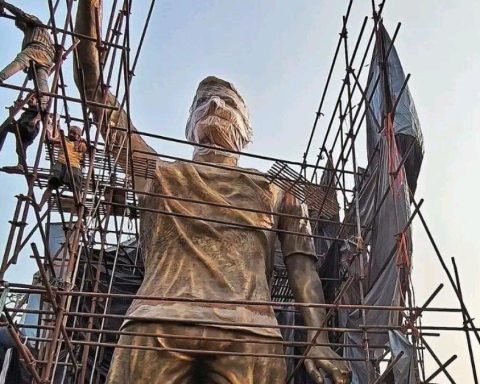On June 9, 2002 it was cold. The International Monetary Fund (IMF) had announced that it would review the Uruguayan accounts on a monthly basis and Víctor Púa was evaluating whether Diego Forlán should play as a starter against Senegal for the third date of the World Cup group stage. But Aldo Bruno, 36 years old and a truck driver, cared little what was happening far away in Korea and Japan.
That day, with his gray suit and his two black suitcases, he got into his father-in-law’s Citroën gas van on the way to the airport. Sitting in the passenger seat, he looked back, and in addition to seeing his partner Alba and their children Fernando and Noelia sitting in the back seat, Aldo looked for the last time at his house on the outskirts of the city of Canelones and he was generated a knot in the belly. Not only would he leave his family to try his luck in the United States, but he had to maintain his integrity because his father-in-law knew half the story.
“We kind of fooled him. We told him it was temporary. That I would go away for a few months and come back”, says Aldo in a telephone conversation from the United States, where he has lived since that distant June 2002. His parents were there, emigrated at the time of the dictatorship, and that made the decision to leave easier.
loaned by the family
Aldo Bruno the day he arrived in the United States
The North American country was the main destination of the emigrants of the crisis, closely followed by Spain. Two out of three people who decided to leave the country due to the crisis went to one of those destinations, breaking the tradition of what those who emigrated between 1970 and 1990 did.
“This change in the orientation of the currents is possibly due to the lack of attractiveness of the countries of the region, due to the economic crisis they have experienced in recent years,” says the work Uruguayan emigration during the 2002 crisis by the Institute of Economy prepared by the economist Andrea Vigorito and the historian and demographer Adela Pellegrino.
Argentina, the traditional destination of the Uruguayans, was the trigger of the Uruguayan crisis and its economic and social situation was equal to or worse than that on this side of the Río de la Plata. In the decades preceding the crisis (70’s and 80’s), Argentina received half of the Uruguayans who decided to leave. Of the emigrants at the beginning of the 21st century, only 8.5% chose to cross into the neighboring country.
How do you come to make the decision to go into exile? “I worked in the Intendancy, in the part of inspections and they did not pay us our salary. They only gave you for electricity and water. And Aldo had been out of work for six months, ”explains Alba Clavijo, Aldo’s wife, who in December 2002 traveled with her 12- and 9-year-old sons to meet up with Aldo on the outskirts of the State of Florida.
Alba speaks quickly, as if trying to prevent the memories of that time from staying in her head. Almost like trying not to remember. “She’s done, it’s over,” she says and her voice threatens to break. It is that with Aldo out of work and she only getting paid to pay bills, raising a family, beyond the occasional aid they could receive, becomes almost impossible. How did they eat? To take care of your children? “One managed, but that’s it, it’s over,” Alba repeats.
The crisis, and the forced economic exile, is usually a traumatic situation to which many find it difficult to return, even if it is only through memories. Even some consulted declined to speak for this note “so as not to relive very screwed up times for the family.”
But others want to speak and have things to say against the “manga of scumbags” that ran the country. The anger quickly emerges from the words of Walter Mocchi (65) as soon as he begins to remember that time and does not hesitate to target the “terrible criminals” who, according to what he says, led the country directly to the crisis and him to bankruptcy.
“Leaving my children here was the scariest thing that happened to me in my life,” he says 20 years later from his home in Malvín.
Walter’s street signage company has already entered a complicated year after the crisis. At the beginning of the new millennium, small local companies stopped contracting their services, but they were still “piloting” it. In 2002, large companies, including multinationals, also began to withdraw from the market and the dollar’s spike in June was the “great blow”.
“I went from being a guy with a normal life to thinking about shooting myself every day,” he says bluntly and graphically: “My father brought a lamb from outside and I didn’t have money to buy firewood. He couldn’t put half a liter of gasoline in the car”. In a few months, he went from having “excellent income” to “having nothing”.
“Leaving my children here was the scariest thing that happened to me in my life,” says Walter Mocchi
Walter, he admits, had a naive management of money and “gave away” the money when his pockets were full. But when the money disappeared, he started picking up phones trying to talk to those he had once given a hand to. “I decided to leave the day I called an acquaintance to whom I had once done a favor and out of anguish I began to cry inconsolably. Not only did he not help me, but he had put me on speakerphone so that others could listen, ”he recalls angrily.
He remembers the day he left with mixed feelings. On the one hand the desperation to leave and leave his family and on the other the relief and hope of getting out of the ruinous situation in which he was.
Walter left with Germán, a friend who was also the accountant for his company. And so, with $300 in his pocket, not knowing a word of English, and without documents, he arrived in the United States at the end of 2002.
Walter’s journey through the North Country, between New York and New Jersey, lasted almost two years. “I returned to vote for the Broad Front in 2004,” he says. In that interim he worked in car washes, sign shops, jobs as a graphic designer, and factories. But he failed to stabilize and returned.
Aldo and Alba are still on the outskirts of Miami. With 20 years abroad, they are far from regretting it. “I would have wanted to come 10 years earlier,” says Alba.
Impact
The emigration generated by the crisis was, together with the five-year period 1970-1975 (in the previous and first years of the civic-military dictatorship), the great “negative moment of the migratory balance” in Uruguay and that not only generated consequences for those who emigrate but for the entire population pyramid.
Between July and August 2002 alone, nearly 30,000 people left the country, according to the book With the Counted Days by journalist Claudio Paolillo and, according to estimates by the National Institute of Statistics (INE), there were about 122,000 between 1996 and 2004. .
Of the people of legal age who left between March and December 2002, according to the work of the Institute of Economy, one in three had completed tertiary studies. “In demographic terms, it implies an impact on the structure of the population, it accentuates aging and, in addition, they are young people who stop having children in Uruguay, so there is also an impact on the birth rate,” he explained to The Observer the Master in Demography and Population Studies from the University of the Republic, Martín Koolhaas.
The emigrants of that time were “predominantly young” which “accentuated aging”, generated a “reduction in the birth rate and had an impact on the educational level due to the loss of the young educated population”. In other words, the impact of emigration due to the 2002 crisis deepened problems that Uruguayan society had already had for some time.
This negative migration cycle continued until 2011 when Uruguay managed to change the trend. In the years after the crisis, the government created voluntary return programs that allow furniture and other objects to be brought into the country without paying taxes.
“There is a return process. It is logical that a part of these people return and that was also favored by a positive economic cycle and by the crisis in Spain”, Koolhaas pointed out.
The study of migratory processes in Uruguay is complex because precise figures did not exist for a long time and because, due to an issue of magnitude, no country pays much attention to Uruguayan communities abroad. But beyond the numbers and academic work, the mark of exile on those who made the decision and were able to leave the country remains latent. “That’s it, it’s over,” repeats Alba.

















